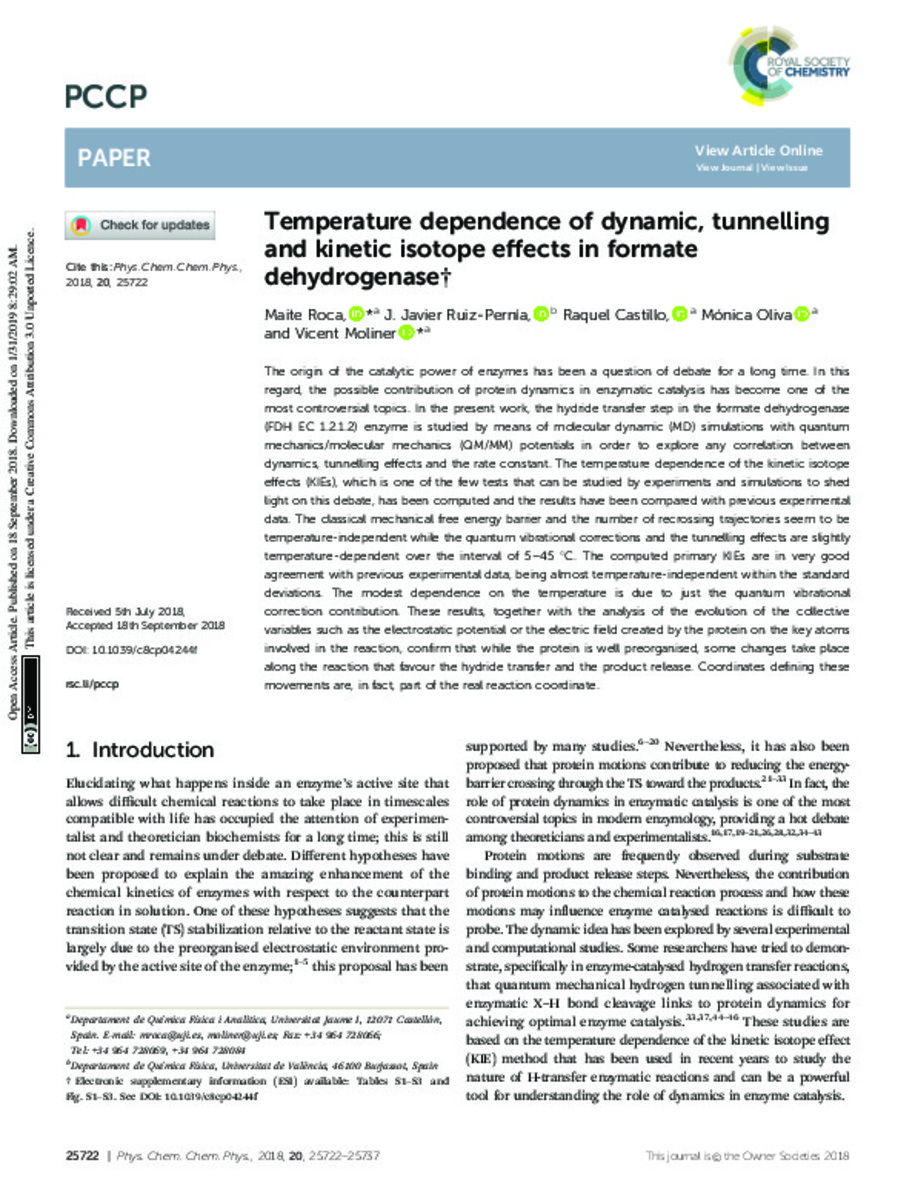Temperature dependence of dynamic, tunnelling and kinetic isotope effects in formate dehydrogenase

Ver/
Impacto
 Scholar |
Otros documentos de la autoría: Roca, Maite; Ruiz-Pernía, José Javier; Castillo, Raquel; Oliva, Mónica; Moliner, Vicent
Scholar |
Otros documentos de la autoría: Roca, Maite; Ruiz-Pernía, José Javier; Castillo, Raquel; Oliva, Mónica; Moliner, Vicent
Metadatos
Mostrar el registro completo del ítemcomunitat-uji-handle:10234/9
comunitat-uji-handle2:10234/7013
comunitat-uji-handle3:10234/8638
comunitat-uji-handle4:
INVESTIGACIONMetadatos
Título
Temperature dependence of dynamic, tunnelling and kinetic isotope effects in formate dehydrogenaseFecha de publicación
2018Editor
Royal Society of ChemistryISSN
1463-9076; 1463-9084Cita bibliográfica
ROCA, Maite, et al. Temperature dependence of dynamic, tunnelling and kinetic isotope effects in formate dehydrogenase. Physical Chemistry Chemical Physics, 2018, vol. 20, no 40, p. 25722-25737.Tipo de documento
info:eu-repo/semantics/articleVersión de la editorial
https://pubs.rsc.org/en/content/articlelanding/2018/cp/c8cp04244f#!divAbstractVersión
info:eu-repo/semantics/publishedVersionResumen
The origin of the catalytic power of enzymes has been a question of debate for a long time. In this regard, the possible contribution of protein dynamics in enzymatic catalysis has become one of the most controversial ... [+]
The origin of the catalytic power of enzymes has been a question of debate for a long time. In this regard, the possible contribution of protein dynamics in enzymatic catalysis has become one of the most controversial topics. In the present work, the hydride transfer step in the formate dehydrogenase (FDH EC 1.2.1.2) enzyme is studied by means of molecular dynamic (MD) simulations with quantum mechanics/molecular mechanics (QM/MM) potentials in order to explore any correlation between dynamics, tunnelling effects and the rate constant. The temperature dependence of the kinetic isotope effects (KIEs), which is one of the few tests that can be studied by experiments and simulations to shed light on this debate, has been computed and the results have been compared with previous experimental data. The classical mechanical free energy barrier and the number of recrossing trajectories seem to be temperature-independent while the quantum vibrational corrections and the tunnelling effects are slightly temperature-dependent over the interval of 5–45 °C. The computed primary KIEs are in very good agreement with previous experimental data, being almost temperature-independent within the standard deviations. The modest dependence on the temperature is due to just the quantum vibrational correction contribution. These results, together with the analysis of the evolution of the collective variables such as the electrostatic potential or the electric field created by the protein on the key atoms involved in the reaction, confirm that while the protein is well preorganised, some changes take place along the reaction that favour the hydride transfer and the product release. Coordinates defining these movements are, in fact, part of the real reaction coordinate. [-]
Publicado en
Phys. Chem. Chem. Phys., 2018, 20.Proyecto de investigación
CTQ2015- 66223-C2, CTQ2015-65207-P and CTQ2015-74523-JIN(AEI/FEDER) ; UV-INV-AE11-40931; UJI-B2016-28 and UJI-B2017-31 ; RYC-2014-16592Derechos de acceso
info:eu-repo/semantics/openAccess
Aparece en las colecciones
- QFA_Articles [812]
El ítem tiene asociados los siguientes ficheros de licencia:













